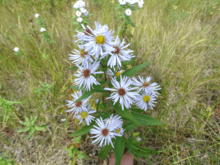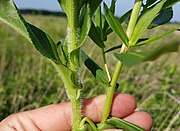Symphyotrichum firmum
Symphyotrichum firmum (formerly Aster firmus), commonly known as shining aster, glossy-leaved aster, smooth swamp aster, or smooth-stemmed aster, is a perennial herb native to Canada and the United States.
| Symphyotrichum firmum | |
|---|---|
 | |
| In Ontario, Canada | |
| Scientific classification | |
| Kingdom: | Plantae |
| Clade: | Tracheophytes |
| Clade: | Angiosperms |
| Clade: | Eudicots |
| Clade: | Asterids |
| Order: | Asterales |
| Family: | Asteraceae |
| Genus: | Symphyotrichum |
| Subgenus: | Symphyotrichum subg. Symphyotrichum |
| Section: | Symphyotrichum sect. Symphyotrichum |
| Species: | S. firmum |
| Binomial name | |
| Symphyotrichum firmum | |
Distribution
Its range is poorly known due to confusion with the closely related Symphyotrichum puniceum.[1] In Canada it has been recorded from Alberta to Quebec.[2] In the United States, it occurs in the Midwest, some parts of the Northeast, and in the Appalachian Mountains south to Georgia.[1][3][4] It is more common in the western part of its range.[3]
Taxonomy
Symphyotrichum firmum is closely related and morphologically very similar to S. puniceum (purple-stemmed aster), and is not always treated as a separate species. However, there is little evidence of intergrades between the two taxa, and most sources now treat them as distinct.[1][3]
Description
Symphyotrichum firmum can reach heights of up to 2 m (6 ft 7 in). It forms large colonies with long, creeping rhizomes. The stem is hairless or it may have stiff, short hairs, often formed in vertical lines. It is sometimes dark red or purple at the nodes (where the leaf connects to the stem). The leaves are alternate, up to 15 cm (5.9 in) long and 3 cm (1.2 in) broad, and clasp the stem. The main vein on the lower leaf surface is hairless or slightly hairy near the tip.[1][3]
It flowers between August and October. The flowerheads are 1.5 to 3.5 cm (0.59 to 1.38 in) across with up to 40 ray florets and 50 disc florets. The ray florets range from white to pale blue or lavender. The disc florets are yellow to cream-colored, becoming pink or purple with maturity. [1][3]
Compared to S. puniceum, this species is less hairy overall, has denser inflorescences of smaller, whiter flowers, and grows in larger, denser patches.[5][3]
 Symphyotrichum puniceum on left and S. firmum on right
Symphyotrichum puniceum on left and S. firmum on right
Ecology
Symphyotrichum firmum grows in moist, sunny areas, such as fens and wet prairies.[5][6] It is often found growing with S.puniceum.[3] Unlike S. puniceum, it sometimes spreads into drier areas.[5]
Many species of bees have been observed visiting the flowers, including Agapostemon virescens, Bombus spp., Ceratina spp., Halictus ligatus, and Melissodes druriella.[6]
References
- Brouillet, Luc; Semple, John C.; Allen, Geraldine A.; Chambers, Kenton L.; Sundberg, Scott D. (2006). "Symphyotrichum firmum". In Flora of North America Editorial Committee (ed.). Flora of North America North of Mexico (FNA). 20. New York and Oxford – via eFloras.org, Missouri Botanical Garden, St. Louis, MO & Harvard University Herbaria, Cambridge, MA.
- Brouillet L, Desmet P, Coursol F, Meades SJ, Favreau M, Anions M, Bélisle P, Gendreau C, Shorthouse D, and contributors (2010+). "Symphyotrichum firmum (Nees) G.L. Nesom". data.canadensys.net. Database of Vascular Plants of Canada (VASCAN). Retrieved 7 January 2020.CS1 maint: uses authors parameter (link)
- Warners, David P.; Laughlin, David C. (1999). "Evidence for a species-level distinction of two co-occurring asters: Aster puniceus L. and Aster firmus Nees" (PDF). Great Lakes Botanist. 38 (2). Retrieved 8 January 2020.
- "Symphyotrichum firmum (Nees) G.L.Nesom". Plants of the World Online. Royal Botanic Gardens, Kew. Retrieved 5 January 2020.
- Reznicek, A. A.; Voss, E. G.; Walters, B. S. "Symphyotrichum firmum". Michigan Flora Online. University of Michigan. Retrieved 7 January 2020.
- Wilhelm, Gerould; Rericha, Laura (2017). Flora of the Chicago Region: A Floristic and Ecological Synthesis. Indiana Academy of Sciences.